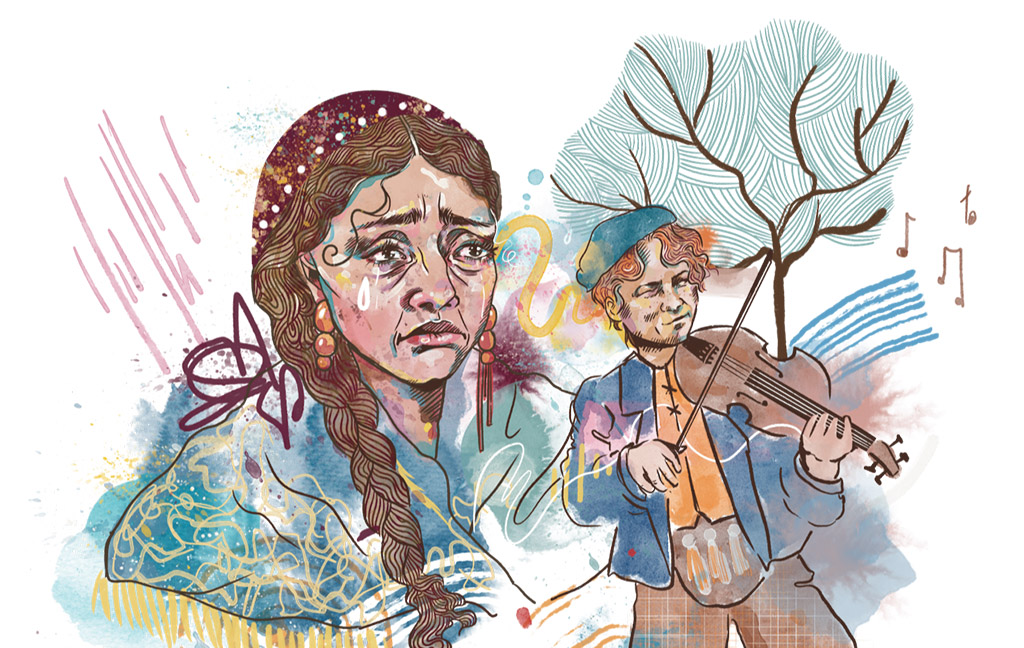Among the treasures of the Clan Macpherson—displayed in their museum in Newtonmore, in the Scottish Highlands—is a broken fiddle. This fiddle has lain silent since it was played and then broken by Jamie Macpherson in 1700.
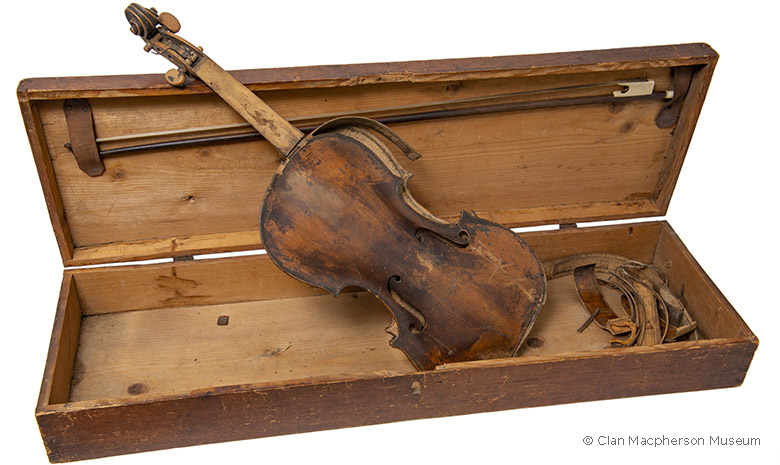
Jamie Macpherson’s fiddle can be seen in the Clan Macpherson Museum in Newtonmore.
The story that this unusual object holds is one of lies, love and of a law that discriminated against the free-souled people that wandered the countryside. It has also held a hidden tale, of the heart that broke with the fiddle, over three hundred years ago. In this blog post, we travel on a journey towards this untold story, which was brought to life recently by Maggie McPhee.
The journey starts at a Highland wedding, moving through a childhood among the hills and heather around Invereshie House. Along the way, is a jail break in the north of Scotland, a bloody battle at Keith’s midsummer fair, ending up at the foot of Banff gallows. This is the story of Jamie Macpherson whose broken fiddle lies in the museum. The fiddle has now been the inspiration for a new story, which brings the tale of the fiddle and its owner alive in new ways.
From two different worlds
Jamie Macpherson was born around 1675 to a Macpherson laird and a Gypsy woman, who met at a wedding. His mother and father were unmarried and as a young lad, Jamie grew up in Invereshie House, his father’s home.
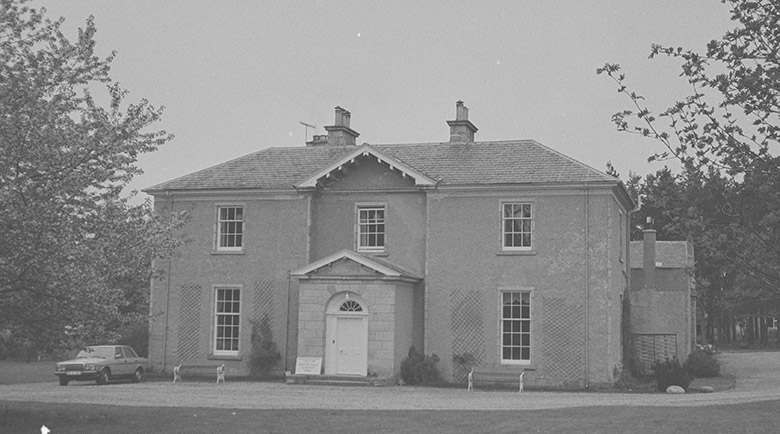
Invereshie House was extensively remodelled in the 1830s. However, some of the original features remain in this Category B listed building. Find out more on our Heritage Portal.
He was visited each year by his mother as she travelled the Highlands and when his father died, he returned to her people. In their company, he was immersed in the culture and language of the Travelling people. Around campfires he would have heard, learned and shared music, songs and stories from this rich culture (one that is still alive and well today).
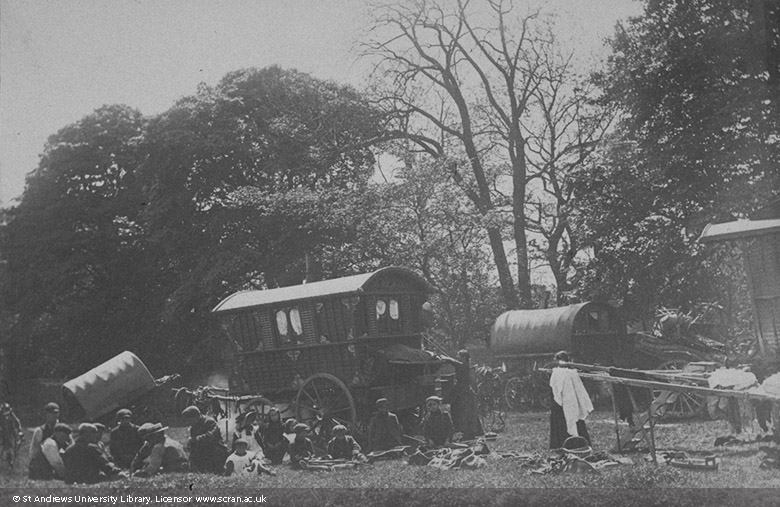
This photo, taken in 1904, shows a caravan at Meigle in Perthshire. © St Andrews University Library. Licensed via Scran.
Unjust laws, however, made it illegal to be a Gypsy in Scotland at that time. From the moment he returned to his mother’s folk, he was considered a criminal, on the run from the law. Captured in Aberdeen, he escaped jail and execution with the help of a cousin. A powerful local landowner, Lord Braco of Duff, however, was determined to see Jamie and the men he travelled with dead.
Bloodshed at a fair
In September 1700, Jamie was with friends among the throngs at the St Rufus Fair in Keith, when they were ambushed. Although they put up a good fight they were overcome and locked up in Banff.
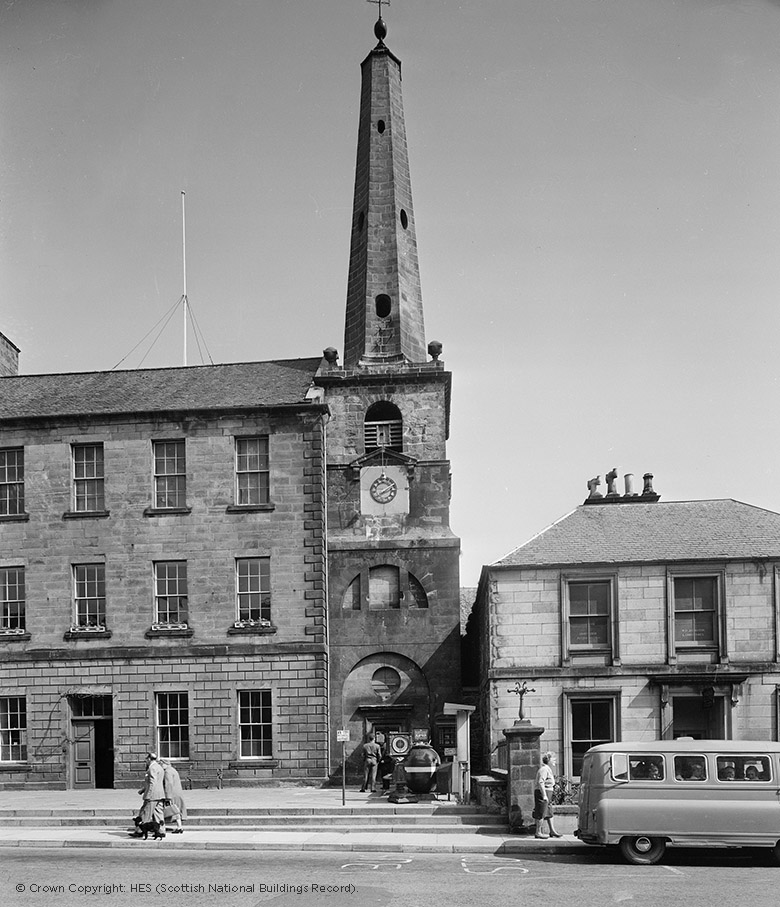
Banff Tolbooth was constructed on this site in 1712. The impressive category A listed steeple was added in the 1760s. The tolbooth and jail were extensively remodelled in 1801 and are now category B listed.
Four of them were tried in early November by an hereditary judge. Hereditary judges were untrained in law but given power to hold trials in their local area. Two of the men, both Browns, were given a stay of execution. Jamie Macpherson and James Gordon, however, were sentenced to death on the charge of being Gypsies and hanged on 16 November 1700.
A tragic death
Many tales have grown up around the death of Jamie Macpherson’s tragic death. It is said that a reprieve was secured for him but that Braco, hearing of this, had the town clock put forward to ensure the sentence was carried out. When he got to the gallows, we are told, Macpherson played a lament, composed while in jail. Known today as Macpherson’s Rant, it captured the imagination of Robert Burns, who later wrote his own version, ‘McPherson’s Farewell’.
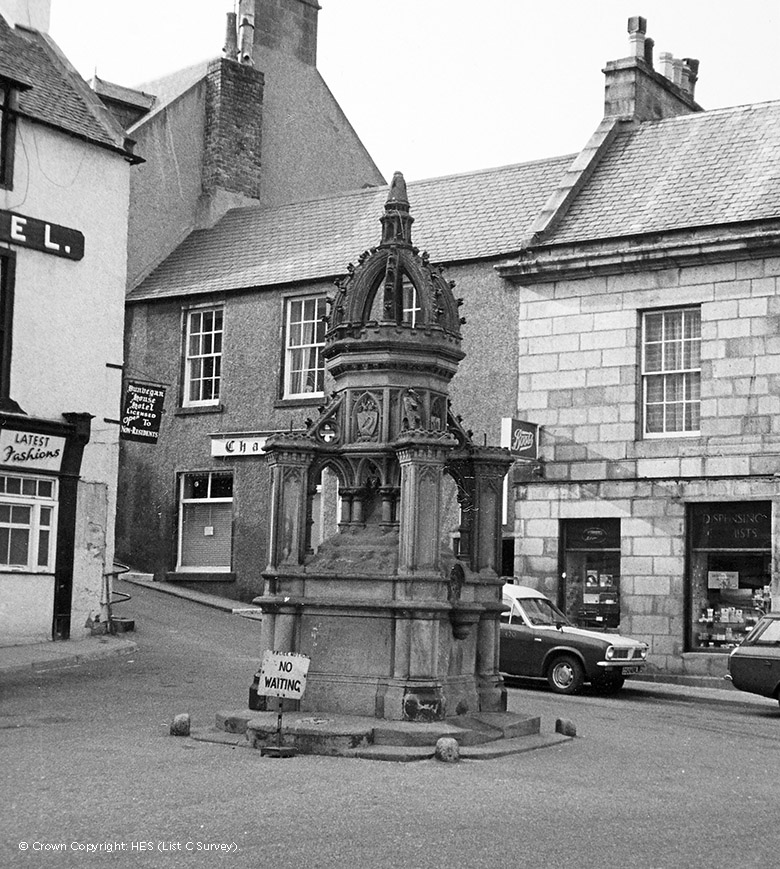
The category B listed Biggar Fountain in Banff was built in 1878. It is thought it was built on the site of the old gallows.
Since 1952, his fiddle, which was broken at the gallows in Banff, has been displayed in the Clan Macpherson Museum, treasured for its connection to the son of a Macpherson laird and to the song published by Burns.
Asserting a place in history
Missing from the story told within the museum, was Jamie’s Gypsy heritage and the unjust reason for his execution. When the museum planned a recent refurbishment, they invited Maggie McPhee to be involved in telling the story of the fiddle. Maggie is a writer and a Scottish Traveller. The new perspective that Maggie brought, however, was not just as a Traveller, but as a woman. She could see that it was not only the story of Macpherson as a Gypsy that was hidden within the museum, but the story of his mother. Throughout the many stories told of Macpherson since he died over three hundred years ago, none record details about his mother. She was a woman without a name, a story, or a voice. As Maggie noted, in so much of history, women’s stories (and Gypsies’ too) go untold.
So, when Maggie came to write the story of Jamie Macpherson for the Clan Macpherson Museum, she decided to tell it in the voice of his mother. Although this woman, so key to the story of Jamie Macpherson, was unrecorded by history, Maggie McPhee has given her a voice. Drawing on her experiences as a Traveller and a mother, she has brought Jamie’s mother alive to tell the story of his life and death.
Maggie has included words from her own language, the Cant, which is known, from evidence presented at Jamie’s trail, to have been spoken by the women who travelled with Macpherson. Definitions of these words, and also of the Scots words used, are included in a glossary at the end of this blog.
Heartbreak Through Her Eyes
By Maggie McPhee
I want to tell you about my son, Jamie Macpherson. His father and I met at a wedding, he was a Highland laird and a very charming man. Back then I was a young Traveller girl. A few months later, in 1675, Jamie was born in Banff, Scotland. His father took my wean fae me to be brought up in Invereshie House. Those years without my Jamie were hard. I would travel far to his father’s kain and watch him quietly from the shadows of the trees as he played gird and cleek with his nurse-maid in the garden.
Many times I wanted to cry out to him, to hold him but I couldn’t and it broke my heart. When Jamie’s father died a few years later he came looking for me and my people. We took Jamie into our clan and he fitted just right. As time went on Jamie grew to be a handsome young man. He was so tall and strong and could out-fence any man with a sword. Musically gifted, he would often sit aroond the campfire, playing the fiddle and we would listen as his beautiful melodies filled the air.
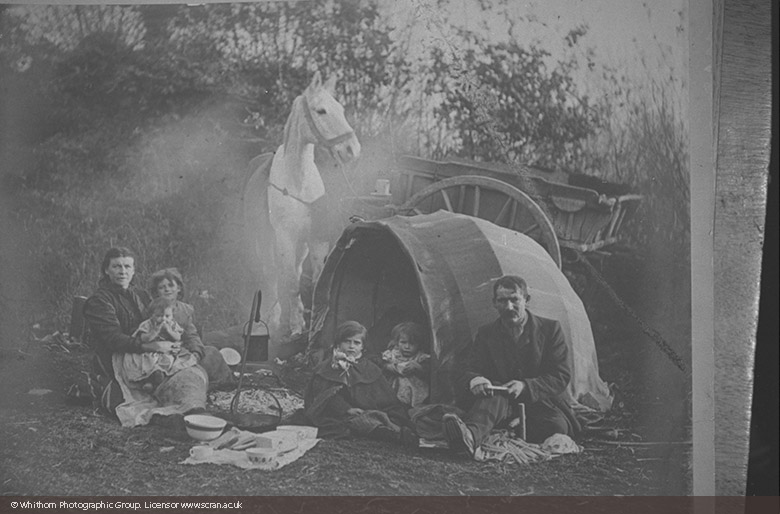
A Gypsy family camped in Galloway, around 1906. © Whithorn Photographic Group. Licensed via Scran.
As Jamie got older he wandered the countryside with a puckle of nae yoosers, robbing from the bien hantle. But he was always good and kind to the poor. Everyone liked my boy, except for his enemy the sleekit Lord Braco, a rich landowner with a grudge.
One day, Jamie and his friends were at the St Rufus Fair in Keith, Braco and his men attacked them viciously, killing one man. Jamie’s armed crew fought back with all their might but they were overpowered and taken to Banff prison.
Injustice and deception
Soon, Judge Dunbar, a friend of Lord Braco, sentenced my Jamie to be hung just for being a Traveller. With fear and desperation, I made my way to Turriff where I begged and pleaded for my laddie’s life. They took pity on me and showed mercy for my boy and gave him a reprieve.
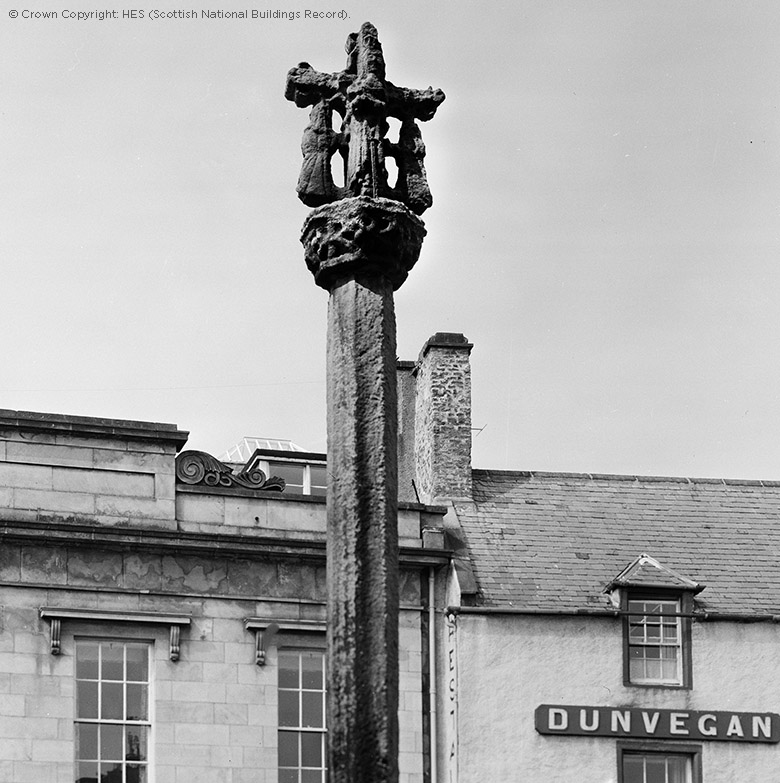
Over the years, the mercat cross in Banff has moved quite a bit! From 1768 until 1900 it stood on top of a doocot outside the town. However, during Jamie Macpherson and his mother’s time it would have been in Low Street, where it stands once again.
I fled from the courtroom. I rode back fast to Banff but I was too late – my boy was gone from this world. Lord Braco heard about the reprieve, he knew it was going to save my boy’s life so he put the clock forward 15 minutes and Jamie was hanged. My heart broke into a million pieces and I fell to the grund sobbing.
It was later on that they told me how brave Jamie was – how he stood at the bottom of the gallows and played a soulful tune on his fiddle. When he finished, he offered up his fiddle to anyone who was standing there but nae haet would take it. So, he broke it on the gallows and flung it on the grund. After the hanging, one of Jamie’s friends picked up the fiddle, wrapped it in a shawl and gave it to me. I locked it in the family kist as it was all I had left of my son.
Jamie Macpherson died on 16 November 1700.
I’ve lived a life of sturt strife
I die by treachery
At once my heart, I must depart
And not avenged be.
Finding a voice
Maggie’s words can now be found in the Clan Macpherson Museum, where they appear alongside Jamie’s broken fiddle, his sword and the workings of the Banff town clock. The journey to giving this Gypsy woman a voice was taken with other women too. Maggie worked with poet and researcher, Dr Jo Clement, Eildih McLean of Article 12 in Scotland and Rhona Ramsay, who researches Gypsy/Traveller objects in Scottish museums, to develop the story of the heart that broke with Macpherson’s fiddle.
Glossary of Cant and Scots words
(Cant is one of the languages of Scottish Gypsy/Travellers)
bien hantle the well-to-do or gentry
fae from
grund ground
kist a chest for keeping important belongings in
nae haet not a one, no body
nae yoosers no use, or up to no good
puckle small number or group
sleekit sly
wean child
About the authors
This blog was co-authored by Rhona Ramsay and Maggie McPhee. Rhona is a PhD Researcher at the University of Stirling. She is exploring Nacken chaetrie (the material culture of Gypsy/Travellers) in Scottish museums. Maggie is a writer and poet. She’s a Scottish Traveller who lives on a Traveller site in Perth.
Scotland’s Year of Stories
Jump into more tales of Scotland in our other blogs celebrating Scotland’s Year of Stories.
Banner image: Jamie Macpherson and his mother, illustrated by Jacqueline Briggs.

